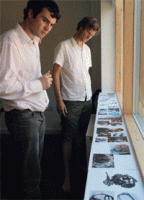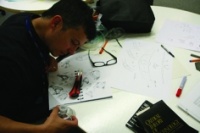
The concepts of ‘design’ and ‘designers’ aren’t well understood in the UK. Talk to a member of the public and their first thoughts are likely to be of fashion. However, even in the technology community, there are many who don’t realise what designers do and how it can benefit their work.
Industrial designers can have a major input on engineering projects, especially when the final goal is a product that people have to use. Now a team from the University of Cambridge’s Institute for Manufacturing is trying to bring the benefits of design into a different area: blue-skies science.
The project, called Design in Science, is led by James Moultrie, a design-management specialist investigating how engineering design can help enhance innovation in institutions of various sizes. His team includes Alex Driver, a research associate who spent three years as an industrial designer with Atkins; and PhD student Carlos Peralta-Mahecha, looking specifically at the interaction between design and science
The inspiration for the project came from the Sainsbury Review: the government’s roadmap for research and development (R&D) in the UK, published in 2007. Lord Sainsbury, the review’s author, praised university and industrial research and recognised the strength of the creative industries, noting that the two should work more closely to encourage innovation. Moultrie was thinking along similar lines, so he set up the Design in Science team to collaborate with other Cambridge research teams in a variety of scientific fields. The team is currently working on projects in medicine, chemistry and engineering.
‘What we’re trying to do is to see whether design can help with primary science,’ Driver said. ‘We know that it’s beneficial in developing new technology, but it’s usually applied when we already know what the technology is and, in general terms, how it works. We also know that the earlier designers get involved in a project, the more successful it tends to be. So it makes sense to think about whether there may be benefits to bringing designers on board in the early-stage research, while the investigators are working on the details of their projects.’
The Design in Science project aims to answer two questions: how can designers play a role in early-stage scientific research and to what extent should they be involved; and how will the role of the designers and their impact on the project be influenced by factors such as the type of science involved, its complexity and the extent to which the science is applied in the research.
Isaac Newton, arguably the University of Cambridge’s most famous son, was an early proponent of the scientific method. This involves scientists bringing to bear on their work the principles of their particular expertise, mathematics, technical knowledge, the conceptual foundations of the project and rigorous experimental methods. Designers, at first sight, are a little less hard-edged. Their expertise lies in the softer sciences: user and market research; the social and cultural perspectives of how people interact with things and incorporate them into their lives; visualisation and modelling; the aesthetics of form and colour; and ergonomics; the way the human body interfaces with and operates the objects with which people come into contact.
At first glance, there’s little common ground. But Moultrie’s team has identified some areas where there could be potential benefits. Designers are adept at identifying applications for research findings and their routes to market; they can also help with the communication and dissemination of research results. Interdisciplinary research is often the most fruitful, with the differing perspectives of the team members sparking off unexpected ideas and steering the research in new and interesting directions. All of this, the team believes, can also help to make funding applications more compelling to the fundholders and more likely to succeed.
The project started with the team looking at the perceptions of both scientists and designers of their respective disciplines, to gather ideas about how the two might interact. They then began to work on practical case studies, working towards a design brief and close interaction between both scientists and designers.

‘Perhaps the obvious place for us to interact is in designing apparatus of some sort, probably in the later phases of a research project,’ Driver said. ‘That’s one of the things that makes medicine an attractive area, because they’re often working on something that is actually going to be used by doctors and patients, and also because there’s a relatively short duration between coming up with the concept and something actually going into use. But we also want to get involved at the early stages of some blue-sky project where there isn’t an obvious application. One of the things we could do is to perhaps design 2D or 3D graphics or animations, so that the researchers can communicate more clearly what their projects are about.’
Designers’ eye for commercial opportunities for research could also be valuable. ‘When you’re working in university research, it’s very rare for someone to be starting something completely from scratch,’ Driver explained; more often, he said, researchers are looking to develop their work into a next phase, or spin off one particlarly interesting finding into a further study. ‘We find that grant applications are much more likely to succeed if they can identify some sort of payback, a contribution to the UK economy, and that’s an area where we might be able to help.’
This assistance could take the form of identifying areas where more research may lead to commercial spin-offs, or finding an appropriate application for the area the scientist wanted to research.
Design in Science is in its early stages and the team is close to the end of its first batch of case studies. ‘At the start, people approached us and asked if we could help, but for the next phase we’re going to actively look for projects where we think we could contribute and approach the researchers ourselves,’ Driver said. ‘Eventually, we’d like to seek more funding ourselves, and make this activity a larger part of what we do at the institute.’
An example of intelligent design
The Design in Science team recently worked with anaesthetists at Addenbrooke’s Hospital in Cambridge. To test their ideas, the team needed an oxygen mask that delivered a closely monitored, accurate dose of oxygen to the patient. The team looked at a variety of mask types and goggles.
They modelled these concepts in 3D and came up with a design that borrowed features from a conventional oxygen mask and other products that attach to the face. This is different to the way industrial designers usually design products, Driver said. ‘Designers would get involved after the research and try to package something jury-rigged but functional that the original researchers had used on their research project; cleaning it up, turning it into something that is easy to use and is manufacturable in bulk. But with this project, the research couldn’t have been done like it was without the designers’ input.’
Driver also said the design work made the first steps in creating a commercially viable product; by the time research is complete, it has produced something fit for purpose.




Swiss geoengineering start-up targets methane removal
No mention whatsoever about the effect of increased methane levels/iron chloride in the ocean on the pH and chemical properties of the ocean - are we...